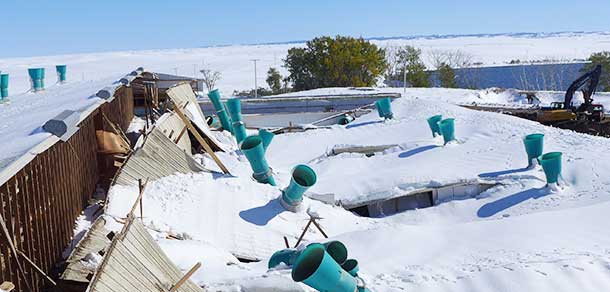The World of Forensic Engineering
Who killed Colonel Mustard in the library with a candlestick?
The mystery is solved within the hour by a team of highly skilled forensic investigators who sweep onto the crime scene with their high-tech gadgets and scientific methods. Forensics continues to intrigue the public, fuelled by a plethora of CSI television shows and movies. In reality, high-profile forensic cases do exist, but they aren’t always a homicide or figured out quite so dramatically. There are other important forensic investigations being solved by a lesser -known team with an equal set of specialized skills.
A partially filled grain trailer failed catastrophically when the centre components buckled during transportation. That is a forensics case in Saskatchewan. And the highly skilled investigators are forensic engineers. They don’t figure out who done it, they figure out why it happened so the failure doesn’t occur again. Unfortunately their cases sometimes sometimes their cases do involve casualties.
A failure could be anything from a bridge collapse to a faulty water pipe. Forensic engineers look at the big picture, using the principles of engineering to work backwards, narrowing down the clues until they find the cause.

“Forensics is a different way of thinking . . .. You have to connect the dots,” says Jason Burtney, P.Eng.
Burtney is with Kova Engineering (Saskatchewan) Ltd. in Saskatoon. While forensics may be popular on TV, Burtney says there aren’t many engineers in Saskatchewan who work in the field. His colleague, Paul Caughlin, P.Eng., M.Eng., remembers one of his first investigations. He had to figure out why a residential basement wall collapsed. The homeowner was so thankful when Caughlin explained the cause of the failure, he went home with two boxes of fresh garden tomatoes. Caughlin says not many major structures and products typically fail in our province. Forensic investigations make up between two and five per cent of the company’s work, but when a case comes along, the engineers like the challenge.
“I think the big draw is being able to apply engineering theory to tell a story of the past,” says Caughlin. “The picture of what happened and why is not always clear as you begin the work, but as we piece together more information the story usually becomes clear.”
The practice of forensic engineering was just formally defined in Canada within the last couple of years, to provide a better understanding of the complex job. That’s likely one of the reasons forensics has never been a conventional discipline within the engineering curricula in university. Professor Doug Perovic would like to see that change. He teaches one of the core courses of a new forensic engineering certificate program offered by the Faculty of Applied Science and Engineering at the University of Toronto. Launched in September 2017, the university calls it a first of its kind in Canada.
“Forensic engineering skills are highly valuable in the assessment of deterioration in infrastructure, product quality and procedural practice improvement as a result of investigations, direct impact on improving engineering design practices and revision of codes and standards to improve public safety,” says Perovic.
Perovic has led hundreds of forensic investigations in his career and says some of his conclusions have resulted in improved products and standards. He wants more students to learn how “reverse engineering logic” is invaluable to finding the correct solution to a real-world problem.
Gravity Engineering Incorporated, based out of Calgary, is a consulting firm specializing in structural engineering investigations throughout Western Canada. Kevin Brown, P.Eng., is a 35-year veteran in the structural engineering industry and has been with Gravity Engineering for the last two decades. Brown says he continues to learn on the job. He travels to symposiums, conferences, and takes various courses to stay on top of the forensics field. Brown says he must be qualified when he investigates a case, as he may have to back up his findings by testifying as an expert witness in court. Depending on the investigation, forensic engineers can be hired by law firms, property loss adjusters, building owners or insurance companies. Brown says forensic engineers have to remember there are no sides and their only job is to figure out what happened.
“We are not advocates for our client’s position. We are an advocate for our opinion,” says Brown.
SGI CANADA has contracted the expertise of forensic engineers for years. A spokesperson for the provincial insurance agency says engineers “help us analyze a loss to identify what happened, why it happened, what are the costs to fix the loss and whether we would have the right to sue or take recovery against a manufacturer for faulty product or the homebuilder for improper workmanship.”
From flood to fire, crashes to collapses – a forensic engineer is a master puzzle solver. Unlike their design-focused peers who often begin a project with a clean sheet of paper, as Kevin Brown says, “forensic engineers start with a mess.”
Top: Roof collapse at foundry (location confidential).
